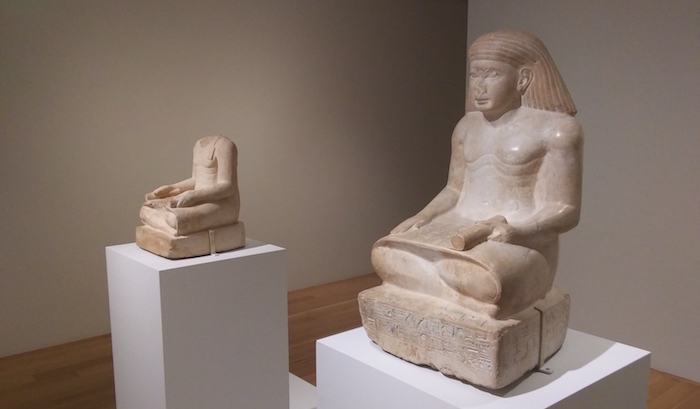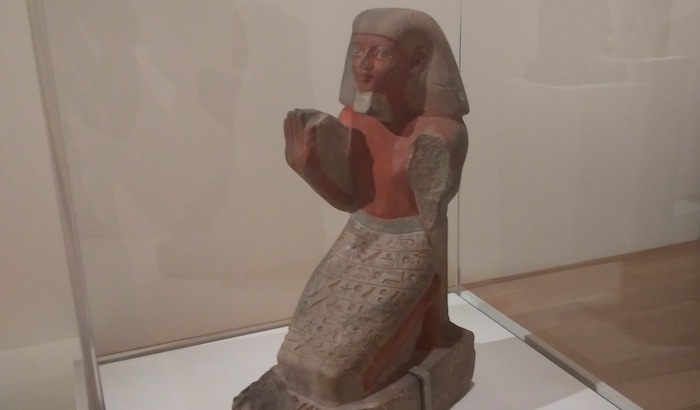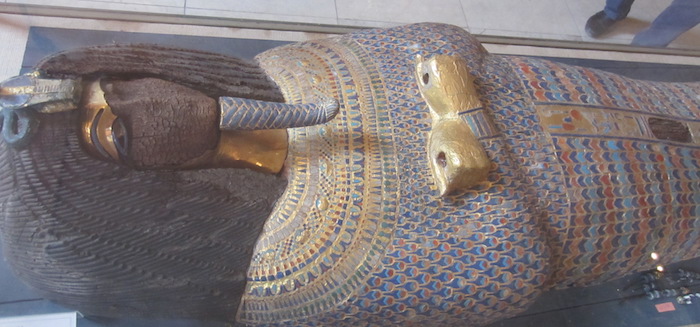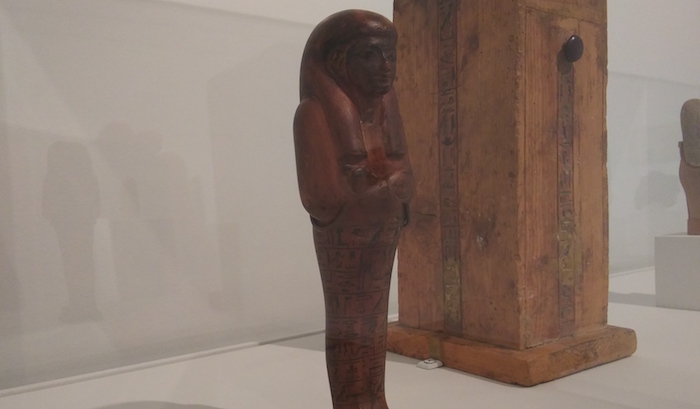Let’s be real for a second: in most fantasy RPGs, stone golems make no sense. It’s a giant hunk of animate stone, and you fight it with… swords? And fire spells? What exactly is your battleaxe supposed to do to this rock? Maybe in your rules set golems take half damage from piercing or double from acid, but these are halfhearted attempts to shoehorn a fundamentally nonsensical combat into some sort of internal consistency. But there’s a better way! And it comes from the amazing world of ancient Egyptian iconoclasm.
Many ancient Egyptian statues have been defaced, damaged, or destroyed. The classic example is the Great Sphinx of Giza, which had its nose removed sometime in the first millennium A.D. But there are patterns to this damage, consistent with different ideologies and intents. Let’s take a look, then see how we can adapt these patterns to stone golems!

Both of these seated scribes were defaced during the Christianization of Egypt (4th century A.D.-ish). Early Egyptian Christians feared objects associated the old religion, and sought to nullify their wicked, pagan magical power. There were lots of ways to ‘kill’ these statues – burning and drowning were the most dramatic – but one sure way to do it was to decapitate them. That’s what happened to the guy on the left.
The scribe on the right, Amunhotep, was saved by his hairstyle. His long hair means his statue is very thick in the ‘neck’, and would be a lot of work to decapitate. Instead, the vandals carved off his nose. Ancient Egyptian religion tightly linked the souls of the dead with their statues and presented the dead as being very like the living. So by knocking off Amunhotep’s statue’s nose, the vandals prevented the soul of Amunhotep from breathing. This rendered his spirit powerless, so he could neither propitiate his pagan gods nor come after the good Christian citizens of contemporary Egypt. Likewise, ancient Egyptian tomb robbers also knocked the noses off statues to keep the dead whose tombs they robbed from coming after them.

The scribe Sety here is praying to Ra. That’s obviously not good for early Christians, many of whom saw Ra as a demon. So they took off Sety’s left arm. In ancient Egypt, the left hand was used to make offerings. Without his left arm, Sety is spiritually impotent, and no longer a threat to the Christian order. With standing figures, vandals often did the same to statues’ left legs, with which you take the first step into the afterlife.
Statues of the gods sometimes carried sacred objects (like Isis’ bottomless cornucopia) in their left hands. Damaging those statues’ left hands or the objects held in them made the statues useless to the faithful. Isis cannot grant you blessings if the cornucopia through which she channels them is damaged! In this way, Christian leaders made it impossible for people to continue practicing their old faith. This forced them to convert, or at least to stop worshipping pagan idols.

This used to be part of the lid of a sarcophagus. Someone attacked it. Greywacke, the stone from which the lid was carved, is tough stuff. It took a lot of work to smash it up like this. One piece of damage is particularly important: the round, flat spot at the base of the chin.
This face used to have one of those long, skinny Egyptian false beards. This sarcophagus was made long after those beards fell out of fashion as a symbol of royalty. Instead, the beard was (at this time) a symbol of the god Osiris. By depicting the deceased as Osiris, it permitted the soul of the dead man to merge with the god and become divine in the afterlife. The tomb robbers who did this damage probably knocked off the beard to un-deify the dead guy so he couldn’t seek revenge.
You also see the beard knocked off the faces of a few older pharaohs, from back when the beard was a symbol of their kingship. Such statues usually had their crowns defaced too. This made them look unlike kings, diminishing their legitimacy. It’s an interesting bit of political propaganda, and scholars still debate who did it and why.

This is all amazing material for making a fight with a stone golem cool. Normal stone golems have no weak points or vulnerabilities. It’s not clear how you’re whittling away this thing’s hit points, since at best you’re just knocking small chunks of stone off it, and none of the chunks really matter. But instead we can rationalize golem stat blocks working the same as other monster stat blocks by using some of the tricks above – and actually make this a really cool fight along the way.
What we have above is a series of weak spots on a stone statue, all tied to the relationship between the figure and the soul or magic it represents.
– Take off its nose and it can’t breathe
– Take off its beard and it’s not divine
– Take off its left arm, left leg, and/or held object in the left hand, and it’s spiritually impotent
– Take off its head and you kill it
If your preferred rules set has a fun system for called shots, you can use that. Otherwise, you can have the players take off the above weak spots when they hit certain damage milestones. At 25 damage, the nose comes off. At 50, the beard comes off. Then – and this is important! – these injuries have an effect on how the golem behaves in combat.
– Taking off the nose has no immediate effect, but as the combat continues, the golem progressively weakens as it runs out of air. This injury can never kill the golem outright (otherwise, the vandals would never have bothered beheading them), but over several rounds of hard fighting, the golem starts to slow.
– Taking off its beard, left arm, left leg, and/or object in the left hand strips the golem of one or more of its magical powers. What flavor this takes strongly depends on what golems look like in your campaign setting.
– Taking off the head kills it for good!

There’s one additional complication I want to inject, by way of this shabty: a humanoid figurine placed in a tomb to do work for the dead in the afterlife.
The little wooden shabty above belonged to someone named Amunemhat, and had his name carved on its stomach. This got complicated when a pharaoh named Akhenaten outlawed the worship of the sun god Amun. The scribe’s name referenced the god, so someone had to enter the tomb, take the shabty, and chisel out the word ‘Amun’, so the shabty’s stomach just said ‘██emhat’. Then Akhenaten died and Amun worship was restored, so someone had to go back into the tomb and write ‘Amun’ on the shabty again to restore Amunemhat’s name. You really have to squint, but you can still make out the lighter, horizontal scratches in the top band of hieroglyphs just below the figure’s arms.
This raises the possibility of deprogramming and reprogramming a golem mid-fight! If you put writing on your golem, a PC who speaks the arcane tongue of the ancients and is handy with a chisel could edit out the parts that say “kill all interlopers” and replace them with something helpful. If it’s good enough for Amunemhat’s shabty, it’s good enough for your fantasy RPG campaign!
–
Source: Striking Power: Iconoclasm in Ancient Egypt, a touring art exhibition. I saw it at the the Pulitzer Art Foundation in St. Louis, Missouri, where it ran March 22 to August 11, 2019.






